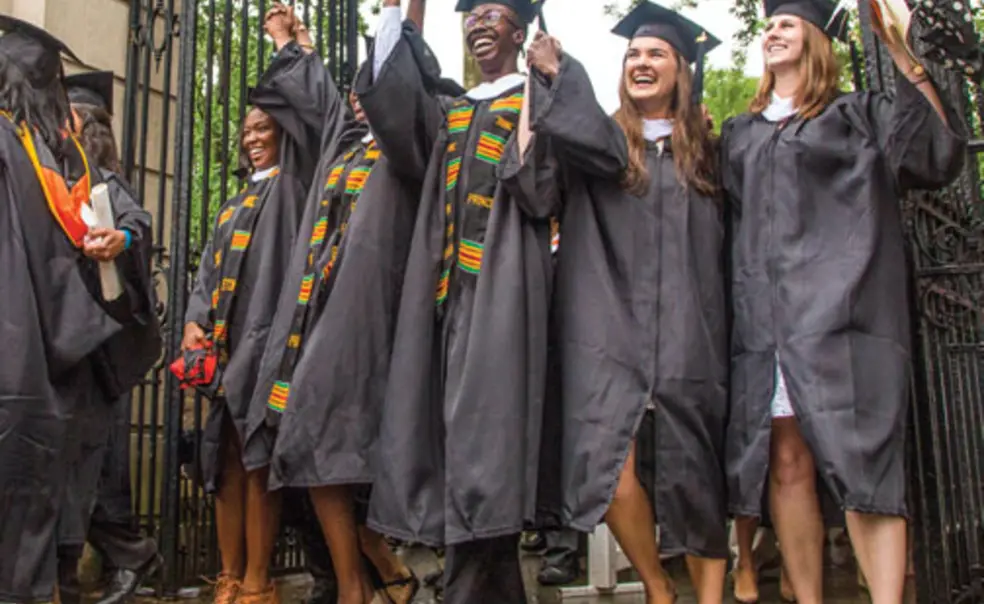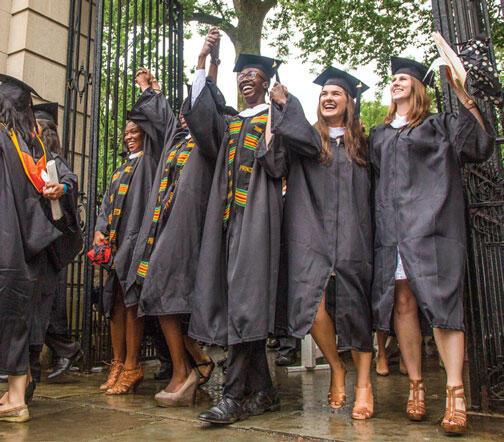Commencement: The Power of the Beautiful and the Profound
The vaunted Nassau Hall weather machine failed us this year, and I accommodated our chilly, rain-soaked audience by abridging the version of the address that I delivered on Commencement Day. Here are the full remarks I had planned to share. — C.L.E.
In a few minutes, all of you will march through FitzRandolph Gate as newly minted graduates of this University. Before you do so, however, it is my pleasure, and my privilege, to say a few words to you about the path that lies ahead.
For many Princetonians, the FitzRandolph Gate has an almost metaphysical significance. The gate marks not simply the edge of the campus, but the border between two worlds: on the one side, what students fondly—or sometimes not so fondly—call the “orange bubble,” a beautiful campus blessed with extraordinary resources, dazzling talent, and heartfelt friendships; and, on the other side, a turbulent world of practical difficulties, ranging from awesome global challenges to mundane personal problems—such as finding an apartment and paying the rent.
But of course the barrier between the campus and the world is not, and has never been, so sharp as the metaphor of the orange bubble would suggest. The world finds its way through the bubble, affecting life on our campus in myriad ways. Princeton, in turn, seeks to project its learning and leadership into the world—to be, as Woodrow Wilson of the Great Class of 1879 said, “Princeton in the nation’s service,” and, as Sonia Sotomayor of the Great Class of 1976 said just last year, “Princeton in the service of humanity.”
We saw visible and poignant expression of those connections this year, including in emotional campus protests demanding justice for black men and women in America. These student-led actions carried forward a tradition of political engagement on this campus that is more than two centuries old—a tradition that expressed Princeton’s connections to the world beyond Fitz- Randolph Gate long before the gate itself ever existed. Indeed, on the day when the Class of 1765 graduated almost exactly 250 years ago from what was then called the College of New Jersey, its members protested British tax policy by resolving to purchase only American-made clothing.
In the years that followed, the connections between Princeton and the outside world manifested themselves in a variety of ways, sometimes loud and noisy, sometimes almost invisible. In 1938, for example, the New York Times reported that although students and faculty earlier in the week protested the University’s decision to award an honorary degree to New Jersey Governor Arthur Harry Moore, the commencement ceremonies on June 21 were placid and beautiful.
According to the Times, more than 2,000 people gathered that day in front of Nassau Hall while “sunshine splashed through tall trees” and “orange canvas across the front of the platform hid all but the ears of the great bronze tigers that have kept guard there for twenty-nine of the building’s 181 years.” The orange bubble indeed! While gentle sunlight washed over orange canvas at Nassau Hall, storm clouds gathered in Asia and Europe, where events would soon plunge the world into a horrific war and unleash one of history’s most awful genocides.
The Times that year listed Princeton’s undergraduate prizewinners in astonishing detail—naming not only the Pyne Honor Prize winner but also more obscure honorees, such as the recipient of the Leroy Gifford Kellogg Cup for Sportsmanship, Play and Influence in Freshman Baseball. The article, however, said not a word about Princeton’s graduate degree recipients. Readers would therefore have no clue that among the 52 students receiving doctoral degrees that afternoon was a young English mathematician named Alan Mathison Turing.
And had they known, they probably would not have cared. Dr. Turing’s thesis was titled “Systems of Logic Based on Ordinals.” It is amusing to speculate about how Governor Moore might have reacted if, after accepting his honorary degree, he had been introduced to the English doctoral student. Perhaps the governor would have complained, as politicians often do today, that Princeton was wasting its money by sponsoring dissertations on abstract topics such as “Systems of Logic Based on Ordinals,” rather than on more practical subjects with immediate application.
Governor Moore might have been surprised to discover that, even while completing some of the most celebrated doctoral research in the history of this University, the brilliant young mathematician could not ignore the world beyond the Fitz- Randolph Gate. Disturbed by the prospect of war in Europe, Turing began experimenting at Princeton with the construction of novel machines that might be used to encrypt information. A fellow graduate student gave him access to the physics department’s machine shop and taught him to use a lathe.
In lighter moments, Turing and his friends in the Graduate College constructed treasure hunts based on elaborate puzzles. One of Turing’s fellow graduate students, Shaun Wylie, was so clever at these games that Turing recruited him to help with the project that occupied him after his return to England. As has happened so many times before Turing and after him, a friendship formed in moments of leisure during tranquil times at Princeton endured and mattered in more urgent circumstances beyond its gates.
Those of you who made it far enough from the orange bubble to get to a movie theater will know something about Turing’s post-Princeton project. Turing’s story is told in The Imitation Game, which, I have to say, must be the first Hollywood blockbuster ever based on a book written by a University of Oxford mathematician about a Princeton University graduate school alumnus and published by the Princeton University Press.
Turing’s genius made him indispensible to the war effort as a code-breaker—an assignment he shared, as it happens, with one of today’s honorary degree recipients, John Paul Stevens, who was awarded a Bronze Star for breaking Japanese codes. Turing led the team that decrypted the Enigma cypher. It is perhaps an exaggeration, but if so only a mild one, to say that this brilliant doctoral student’s work both saved civilization from the Nazis and laid the conceptual foundation for the digital revolution. Not bad for a graduate student working on esoteric topics in theoretical mathematics.
If you have seen The Imitation Game, you also know that the exterior world impinged on Alan Turing’s life within the orange bubble in another, exceedingly cruel way by forcing him to repress his sexual identity. These injustices led eventually to a criminal conviction and suicide at the age of 41. Turing’s biographer, Andrew Hodges, writes that the young mathematician’s social life at Princeton was “a charade. Like any homosexual man [of the time], he was living an imitation game.” Forced to seek acceptance “as a person that he was not… [H]is autonomous selfhood [was] compromised and infringed.”
Sixty-one years after Turing’s death, we live in a more tolerant society. Indeed, thanks partly to legal precedents established by today’s honorary degree recipients John Paul Stevens and Deborah Poritz, we may hope that we can soon see a day when all Americans can express their sexual identities freely and without fear of discrimination or violence.
Yet, though the world you enter today is far different from the one that greeted Alan Turing in 1938, your world, too, is fraught with disturbing challenges. Human activity strains the environment. Violence plagues many parts of the planet. Inequality is near an all-time high in many countries, including this one.
Over the past year, multiple police killings of black men have seared our nation in what the president of the United States has called a “slow-rolling crisis.” The crisis that we face today is only the latest iteration of a challenge embedded deeply within the history and the soul of the American nation. From its inception, the diversity of this nation challenged its leaders and tested the limits of republican governance.
At the time of the country’s founding, most political theorists and many Americans believed that democracies could flourish only if they were small and homogenous. James Madison of the Class of 1771, who lived and studied in Nassau Hall, famously argued that a large and diverse republic could protect liberty more effectively than a small one. His tenth Federalist Paper became a classic of political science and a foundational document in American history. But Madison’s solution was at best a partial one, for he never squarely confronted the great injustice of slavery or the challenge of racial inequality.
Two hundred and twelve years after James Madison earned his undergraduate degree, the Association of Black Princeton Alumni gave to this University a bust of Frederick Douglass. The bust now sits adjacent to this courtyard in Stanhope Hall, the University’s third oldest building, which has in recent years been the home of Princeton’s Center for African American Studies and which yesterday became, by unanimous vote of Princeton’s Board of Trustees, the home of this University’s Department of African American Studies.
Douglass expressed America’s aspirations as passionately and emphatically as anyone. He insisted, in the face of slavery and inequality and all of the manifest flaws in American politics, that the Constitution was rightly interpreted to guarantee the rights and liberties of all people. In a speech given in Glasgow, Scotland, in 1860, he said,
“The Constitution says: ‘We the people’ … not we the white people, not we the citizens, not we the privileged class, not we the high, not we the low, not we of English extraction, not we of French or of Scotch extraction, but ‘we the people.’”
Douglass dared to express an utterly audacious dream—the dream that all of us, despite our differences and our conflicts and our sins against one another, could come together as one people, united by a commitment to liberty. His vision was beautiful and profound and undaunted by the ugly circumstances of his time.
America has since its birth been a land of diversity and a land of audacious dreamers. It has benefited again and again from men and women who shared, against all odds, the dream that we might transcend our differences and yet be one people. It has benefited, too, from individuals who dared to believe that scholarship and education could generate the progress, the discoveries, and the leaders who will help to solve our most difficult problems in our darkest hours.
When you march out FitzRandolph Gate a few moments from now, you will march into a world that urgently requires your commitment to dream audaciously. We hear a great deal these days about the need for what is practical, functional, and utilitarian. I understand that. You really do have to find apartments and you do—you most certainly do—have to pay the rent. But I hope you will also find time to pursue ideals that are beautiful and profound, not just for their own sake, but because, as Alan Turing and Frederick Douglass remind us in their different ways, the beautiful and the profound are sometimes far more powerful and beneficial than all the things that the conventional world praises in the name of pragmatic utility.
And so it is with an eye toward the beautiful and the profound that we gather here today, bursting with joy amidst the turmoil of the outside world, to congratulate you on your achievements and wish you well as you begin your journeys beyond this campus. My colleagues and I on the faculty and in the administration, and my fellow alumni and trustees, hope you will carry the spirit of Princeton into the world, and we look forward to welcoming you back to Princeton whenever you return. We feel great confidence in your ability to meet the challenges that lie ahead, for on this special and auspicious day, you—our graduate students and our undergraduate seniors—are now, and shall be forever into the future, Princeton University’s Great Class of 2015.
Congratulations and best wishes!














No responses yet